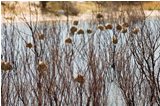Orange River ringing, 12-19 October 2003
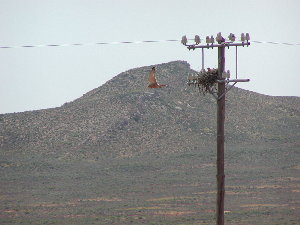 Photo H.D. Oschadleus |
In October 2003 Peter Nupen organised a ringing expedition to the Orange River (near the Fish River confluence) and in Oranjemund. Peter, Mike Ford, Bob Ellis, Doug Harebottle and myself drove to Oranjemund on 12 October. From about Springbok we surveyed nests on telephone poles. These were mostly nests of Pied and Black Crows, but also some Gretaer Kestrels as shown here. |
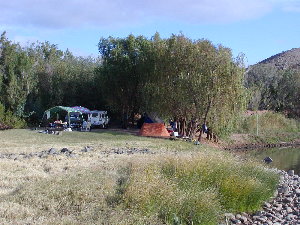 Photo H.D. Oschadleus | We set up camp at the Boom/Orange River confluence on the Namibian side (in the Ai-Ais Park). We lived in tents from Sunday night to Thursday morning. The weather was warm to hot and we could swim in the Orange every day to relax and cool off. |
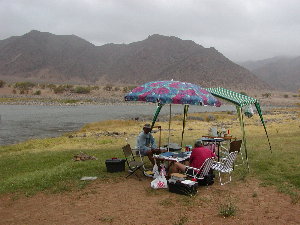 Photo Dirk Heinrich | We ringed near the campsite on the first 2 days. |
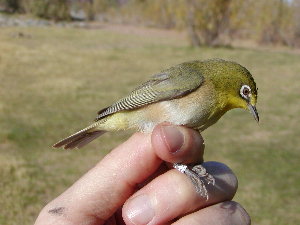 Photo H.D. Oschadleus | The most ringed bird throughout the week, was the Orange River White-eye, a recent split from the Cape White-eye. Note the buffy flanks which distinguish it from the Cape White-eye. 104 of these birds were captured (some of these were retraps of birds ringed by Namibian ringers at the same sites). |
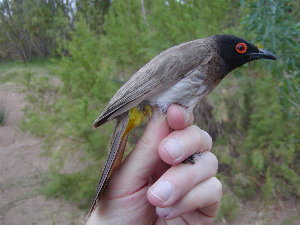 Photo H.D. Oschadleus | The Redeyed Bulbul was the next most frequently captured bird, with a total of 47. |
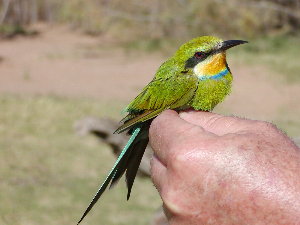 Photo H.D. Oschadleus | Probably the most special birds ringed were 4 Swallowtailed Bee-eaters. |
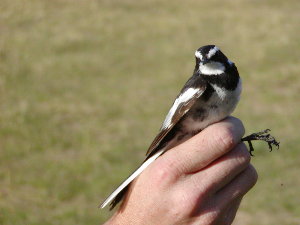 Photo H.D. Oschadleus | African Pied Wagtails were common along the Orange, and very confiding, almost walking into our tents. We tried using spring-traps unsuccesfully, but did catch 4 of these wagtails in our nets as well as 11 Cape Wagtails. |
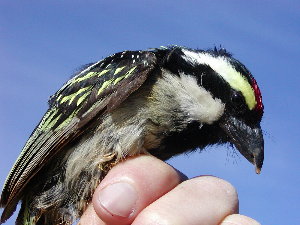 Photo H.D. Oschadleus | Acacia Pied Barbets inflict painful bites with their powerful hooked bills. |
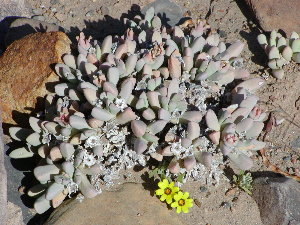 Photo H.D. Oschadleus | The Boom River had little water but many different succulent species. |
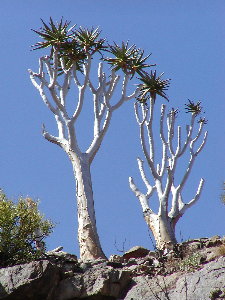 Photo H.D. Oschadleus | Kokerboom Aloe dichotoma was plentiful along the lower Boom R banks. |
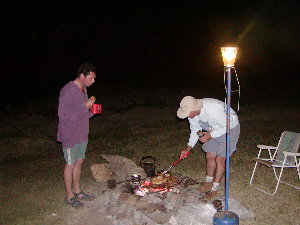 Photo H.D. Oschadleus | We kept a fire going for boiling water during the day, and for cooking supper at night. |
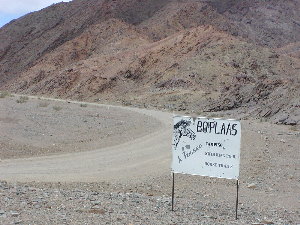 Photo H.D. Oschadleus | On Wednesday and Thursday we ringed at Boplaas farm, several kms east of the Fish/Orange R confluence. |
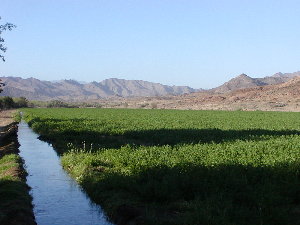 Photo H.D. Oschadleus | The farmer uses water from the Orange to irrigate his lucerne field and his fruit trees, which attract many birds to his property. |
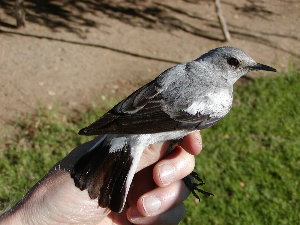 Photo H.D. Oschadleus | Male Mountain Chat. The sooty coloured female was also caught. The pair seemed to be resident around the farm house. |
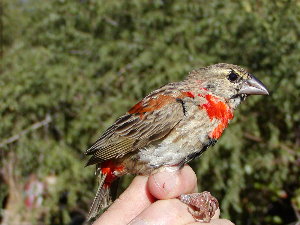 Photo H.D. Oschadleus | There was a flock of Red Bishops in the lucerne fields. The males were moulting into breeding plumage, and we caught males at all stages, from those with very few red and black feathers, all the way to nearly full breeding plumage. |
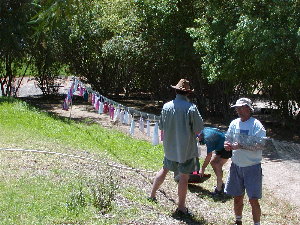 Photo H.D. Oschadleus | After lunch we washed our bird bags and hanged them on a closed net to dry. The bags dried quickly enough to continue ringing in the late afternoon! |
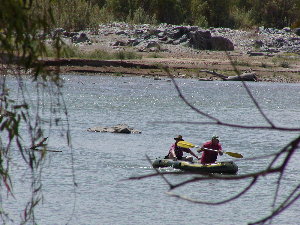 Photo H.D. Oschadleus | Peter and Doug took the rubber duck and were going to paddle back to camp, to survey the waterbirds. Unfortunately the wind was too strong, and they ended up a little behind their starting point. But through this they discovered a heronry on a small island with Darter eggs and a Goliath Heron chick. |
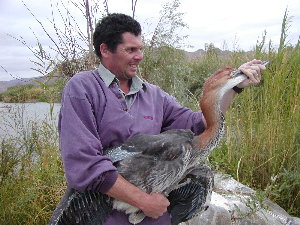 Photo H.D. Oschadleus | Doug and I returned on Thursday morning with a ring for the heron, only the 75th Goliath Heron to be ringed in southern Africa over the last 55 years. The nestling was well feathered but not yet flying - the perfect age for ringing. |
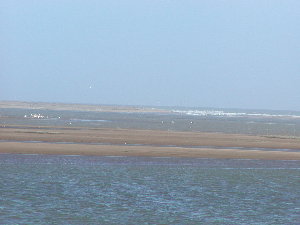 Photo H.D. Oschadleus | After the ringing at Boplaas on Thursday morning, we packed up camp and drove to Oranjemund. We briefly explored the Orange River mouth - there were White Pelicans, Common Terns, and waders. |
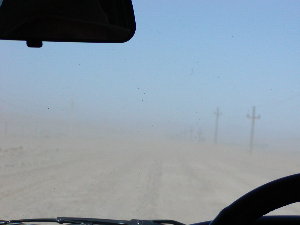 Photo H.D. Oschadleus | On Friday morning we ringed weavers in the reed-beds between the Orange R and the Oranjemund golf course, while Peter Nupen spoke to the school children about bird adaptations. In the afternoon we drove to Hohenfels, a few kms rom Oranjemund into the Sperrgebiet. It was rather windy, meaning lots of dust! |
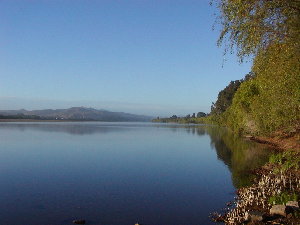 Photo H.D. Oschadleus | Fortunately the next morning was perfectly calm, allowing some good ringing next to the Orange R. |
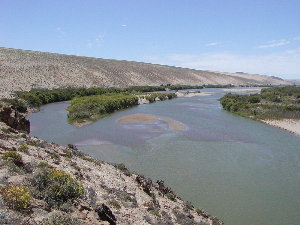 Photo H.D. Oschadleus | View of the Orange from the cliff tops (Hohenfels is German for high rocks). There was a large flock of several hundred Shelduck and a few Egyptian Geese resting on the far shore. |
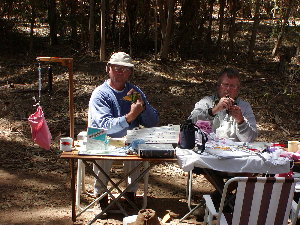 Photo H.D. Oschadleus | There was a shady spot for our ringing tables under some eucalypts. At Hohenfels we recaptured several birds ringed up to 7 years earlier at the same site. |
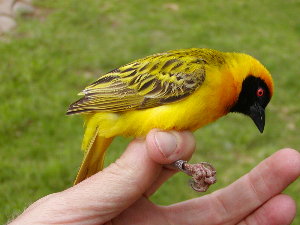 Photo H.D. Oschadleus | Male Masked Weaver of the Namibian subspecies, which is distinctly smaller than the nominate subspecies, and has orange around the mask. |
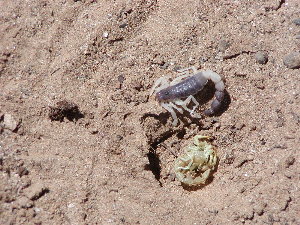 Photo H.D. Oschadleus | Early in the morning I tied a guy-rope to a rock and discovered a scorpion under the rock. The scorpion was starting to shed its exoskeleton. I checked a few times during the day, every time carefully replacing the rock to not injure the unprotected scorpion. By lunch time it had totally shed its exoskeleton (the green skin) but its new skeleton had not hardened yet. |
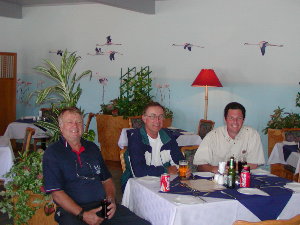 Photo H.D. Oschadleus | In Oranjemund we gave talks to the community and had a ringing demonstration. Our stay in Oranjemund was kindly hosted by Namdeb. We enjoyed lunch and supper at Flamingos Restaurant. |
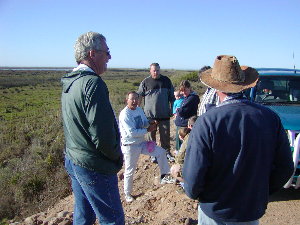 Photo H.D. Oschadleus | Ringing demonstration. |
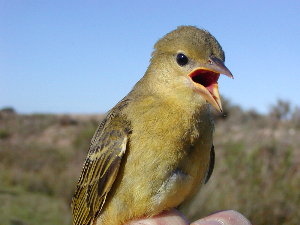 Photo H.D. Oschadleus | Juvenile Cape Weaver. I didn't see any weaver nests but they were breeding as shown by this recently fledged bird, and also many females had brood patches, indicating that they were incubating. |
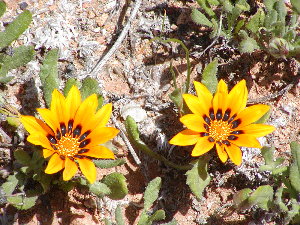 Photo H.D. Oschadleus | Spring flowers at Springbok, on the return journey. |
A special thanks to Namdeb for hosting us in Oranjemund.








